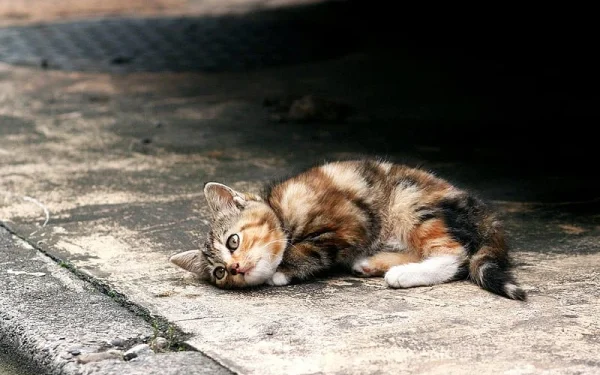Introduction: The Growing Concern Over FPV in India
India is currently facing a new health crisis—this time, it’s not bird flu or a human pandemic, but a deadly virus affecting the feline population. Feline Panleukopenia Virus (FPV), a highly contagious and often fatal disease, has begun spreading rapidly among cats in various regions, particularly in Karnataka. The outbreak has resulted in the death of hundreds of cats within just a few days, causing widespread concern among pet owners and animal welfare organizations.
What is FPV? Understanding the Deadly Virus
Feline Panleukopenia Virus (FPV), also known as feline distemper, is a parvovirus that affects domestic and wild cats. The disease is highly contagious and primarily spreads through direct contact with infected animals, contaminated food, water, bedding, or even human hands that have been in contact with the virus. Once infected, cats experience severe gastrointestinal distress, leading to dehydration, fever, vomiting, and a drastic drop in white blood cell count, weakening their immune system significantly.
Impact of FPV in Karnataka: A State Hit Hard
Reports from Karnataka indicate that Raichur district has been severely affected, with hundreds of cats succumbing to the virus within a short span of time. Veterinarians in the region have stated that the survival rate of infected cats is alarmingly low, with estimates suggesting that only 1% of affected felines may recover.
The rapid spread of the virus has raised concerns about its containment, as it can survive in the environment for extended periods, making disinfection and preventive measures crucial. Given the absence of a specific cure, veterinarians are urging cat owners to take immediate action to protect their pets.
How is FPV Transmitted?
FPV spreads through multiple channels, making it highly infectious. The primary modes of transmission include:
- Direct contact: Healthy cats can contract FPV by coming into contact with infected cats.
- Contaminated surfaces: Food and water bowls, litter boxes, bedding, and human clothing can harbor the virus.
- Fleas and insects: Insects that come into contact with infected cats can act as carriers of the virus.
- Airborne exposure: The virus can spread through respiratory secretions from infected cats, though this is less common.
Why is FPV So Deadly?
One of the biggest challenges with FPV is its aggressive nature. The virus attacks the rapidly dividing cells in a cat’s body, particularly in the intestines and bone marrow, leading to extreme weakness, severe dehydration, and secondary bacterial infections. The symptoms progress quickly, and if not addressed immediately, can lead to death within 24 to 48 hours.
Furthermore, young kittens, unvaccinated cats, and those with weakened immune systems are at the highest risk. Since FPV has a 99% fatality rate among infected cats, prompt action is necessary to prevent further casualties.
FPV and Its Impact on Humans and Other Animals
While FPV is devastating for cats, there is some relief in knowing that it does not pose a risk to humans or dogs. Unlike zoonotic diseases, FPV is species-specific, meaning it only affects felines. However, its rapid transmission and high mortality rate make it a critical concern for pet owners and veterinarians alike.
Prevention and Protection: What Cat Owners Should Do
With no direct cure available for FPV, prevention remains the best approach. Experts recommend the following steps to safeguard cats from this deadly virus:
- Vaccination: The most effective way to prevent FPV is by ensuring that cats receive their core vaccines on schedule. The FPV vaccine is part of the standard feline vaccination protocol and should not be skipped.
- Isolation of sick cats: If a cat shows symptoms of FPV, immediate isolation is crucial to prevent the virus from spreading to other cats in the household or community.
- Proper hygiene and sanitation: Regularly disinfecting food bowls, litter boxes, and other commonly used items with bleach-based cleaners can help eliminate viral particles.
- Limited outdoor exposure: Keeping cats indoors or restricting their contact with stray or infected animals can significantly reduce the risk of infection.
- Early veterinary intervention: Any signs of illness, such as loss of appetite, fever, or diarrhea, should be taken seriously. Seeking veterinary care at the earliest can improve the chances of survival.
Current Measures Being Taken in India
Veterinary experts and animal welfare organizations in India are working to control the FPV outbreak by spreading awareness and educating pet owners on preventive measures. Local veterinary clinics have reported an increase in inquiries regarding FPV vaccinations and emergency treatment for infected cats.
Additionally, animal rescue groups are actively coordinating with authorities to monitor the spread of the virus and provide medical assistance to affected stray cats. Efforts are also underway to launch vaccination drives in heavily affected areas to curb the outbreak.
Conclusion: The Urgent Need for Action
The rapid spread of FPV in India highlights the urgent need for proactive measures to protect the feline population. Pet owners must remain vigilant and prioritize vaccination and hygiene to prevent further fatalities. The collaboration between veterinarians, government agencies, and animal welfare groups will play a crucial role in containing the virus and minimizing its devastating impact.
As the situation unfolds, cat owners are urged to stay informed and take immediate precautions to safeguard their pets. With collective efforts, India can work towards controlling the spread of FPV and ensuring the health and well-being of its feline community.

























